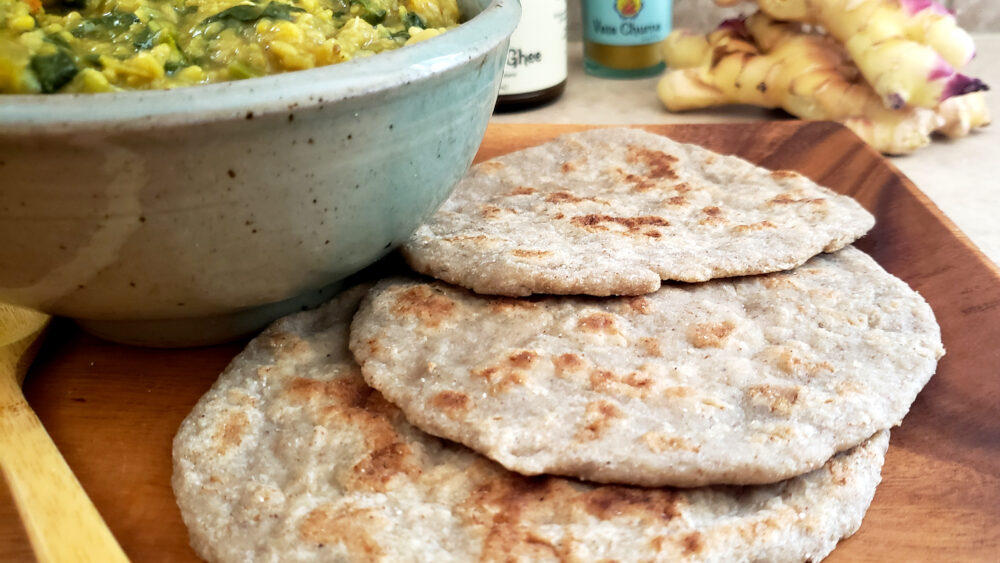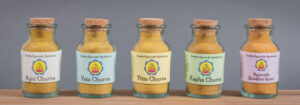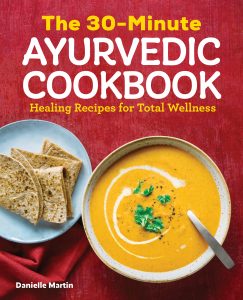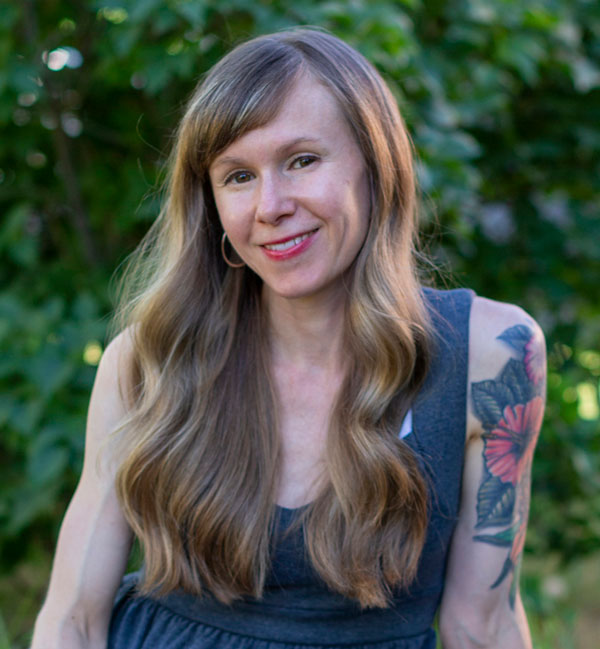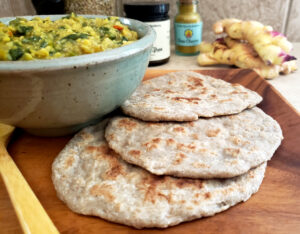 If you have been looking for a gluten-free, guilt-free flatbread recipe that is soft, non-crumbly, flavorful, healthy, and versatile, look no further! This buckwheat-based flatbread checks all of these boxes, and with only six ingredients (and no rolling pin required), it is oh-so-easy to make! It pairs amazingly with soup, stew, kitchari, dal, hummus, nut butters, and spreads, but can also be used as a wrap or even a mini-pizza crust.
If you have been looking for a gluten-free, guilt-free flatbread recipe that is soft, non-crumbly, flavorful, healthy, and versatile, look no further! This buckwheat-based flatbread checks all of these boxes, and with only six ingredients (and no rolling pin required), it is oh-so-easy to make! It pairs amazingly with soup, stew, kitchari, dal, hummus, nut butters, and spreads, but can also be used as a wrap or even a mini-pizza crust.
Buckwheat is one of my favorite whole grains (although it is actually a fruit seed) for multiple reasons. It is lighter and less starchy than many other grains, such as wheat, rice, and oats. It is filled with resistant starches and soluble fiber, making it an excellent prebiotic food to support a healthy microbiome. Buckwheat is also packed with antioxidants, iron, and magnesium. It is a low-histamine food and low on the glycemic index (making it suitable for diabetics). Overall, it promotes heart health, colon health, and gut health while lowering cholesterol and stabilizing blood sugar.
In the world of baking, buckwheat is considered an excellent binder due to its mucilage properties. When paired with the psyllium husk, it helps to make this flatbread soft and cohesive (meaning it won’t crumble in your hands). Buckwheat is slightly drier than wheat, but this is easily remedied by brushing each flatbread with ghee or olive oil after cooking.
From an Ayurvedic perspective, this recipe is excitingly tri-doshic, meaning it is suitable for all three dosha types (i.e. Vata, Pitta, Kapha). With buckwheat being a light, dry, and warming grain, this recipe is most beneficial for Kapha dosha. However, the oil and ghee help to balance out the dry properties for Vata, and the psyllium husk and ghee make it less heating for Pitta. Just in case, however, I have added a few “optional doshic variations” below the recipe to make it more suitable for each dosha type.
Jazz It Up
If you want a little more pizazz in your flatbread, feel free to make it your own with a few flavorful ingredients. Here are some options:
- Add some chopped fresh herbs such as cilantro, rosemary, parsley, thyme, oregano, garlic, or chile peppers.
- Add a dash of dry spices such as Agni Churna, Garam Masala, cumin powder, coriander powder, turmeric, hing, oregano, garlic powder, onion powder, black pepper, or cayenne pepper.
- Replace half of the olive oil with homemade yogurt or kefir.
- Make it a “sweet bread” by adding aromatic spices such as Ayurvedic Breakfast Spices, cinnamon, cardamom, or ginger; then top with a little ghee and honey before eating.
Make it Vegan
- This recipe is essentially vegan on its own; the only change would be to brush the flatbread with coconut oil or olive oil (instead of ghee) after cooking—hoorah!
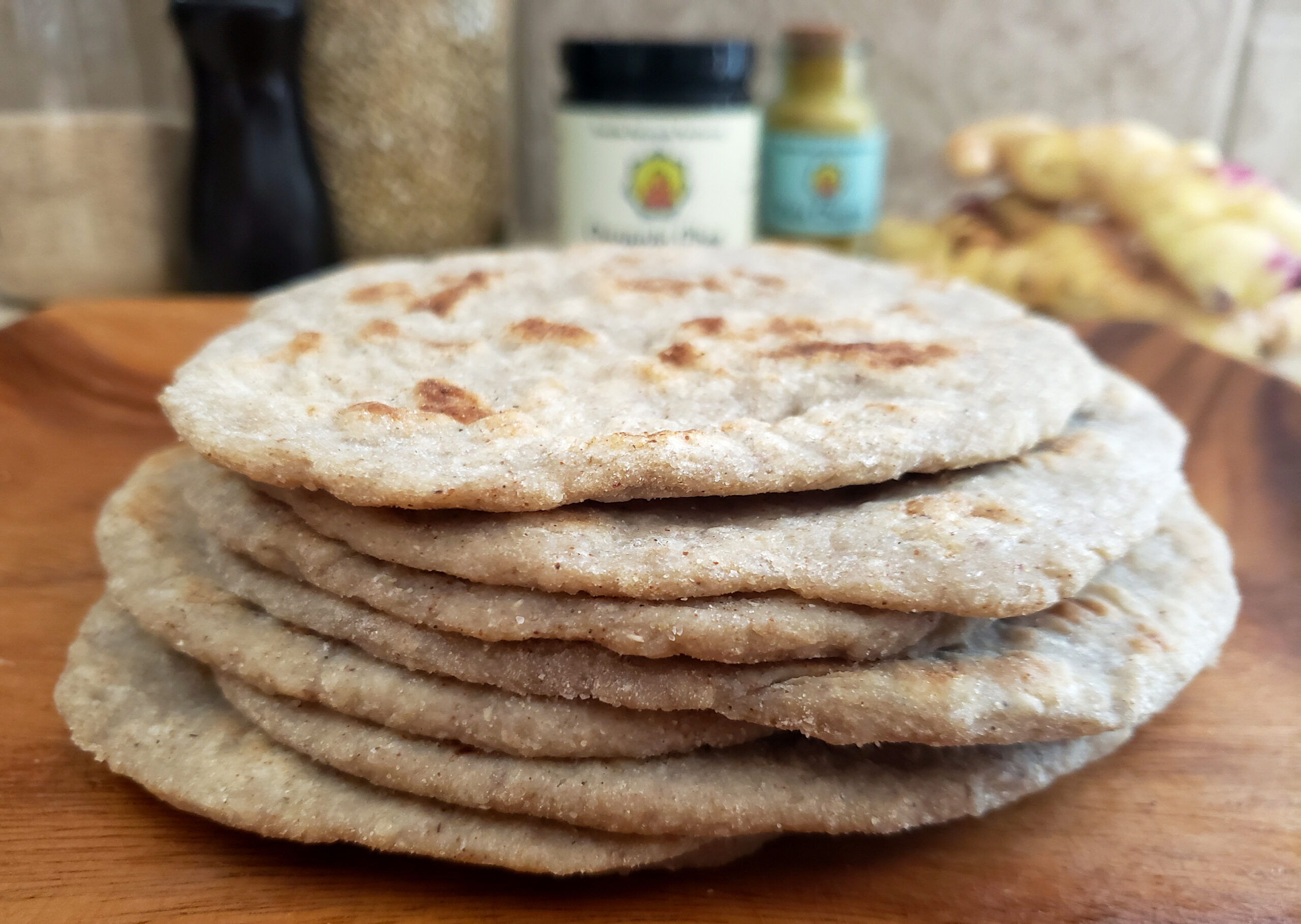
Healthy Homemade Buckwheat Flatbread Recipe
Click here for a printable copy of this recipe.
- Doshic effect: Vata↓, Pitta↓, Kapha↓
- Makes: 8 flatbreads (cut the recipe in half to make four)
- Prep Time: 15 to 20 minutes
- Cook Time: 30 minutes (about 4 minutes per flatbread)
- Gluten-Free, Yeast-free, Vegetarian, Vegan options, Tri-doshic
Materials
Full Disclosure: All Amazon links are affiliate-based but recommended with honesty and care. By ordering directly through these links, you can help support Svastha Ayurveda!
- Measuring cups and spoons
- Small and medium mixing bowls
- Large wooden mixing spoon
- Cast-iron griddle (replace with a large non-stick frying pan)
- Electric spice grinder or high-speed blender (if using whole buckwheat groats)
- Mesh strainer or sifter (if using whole buckwheat groats)
- Rolling pin (optional; I prefer to use my hands!)
Ingredients
Full Disclosure: All Amazon links are affiliate-based but recommended with honesty and care. By ordering directly through these links, you can help support Svastha Ayurveda!
- 1½ cups lukewarm water
- ¼ cup olive oil
- ¼ cup whole psyllium husk, coarse powder
- 1½ cups (240 grams) raw buckwheat groats*
- An extra ½ cup (80 grams) of raw buckwheat groats (for sprinkling the rolling surface to prevent sticking)
- 1 to 1½ teaspoons pink Himalayan salt or mineral salt
- Ghee for cooking and garnish
*If a spice grinder is not available, replace it with 240 grams of pre-ground raw buckwheat flour.
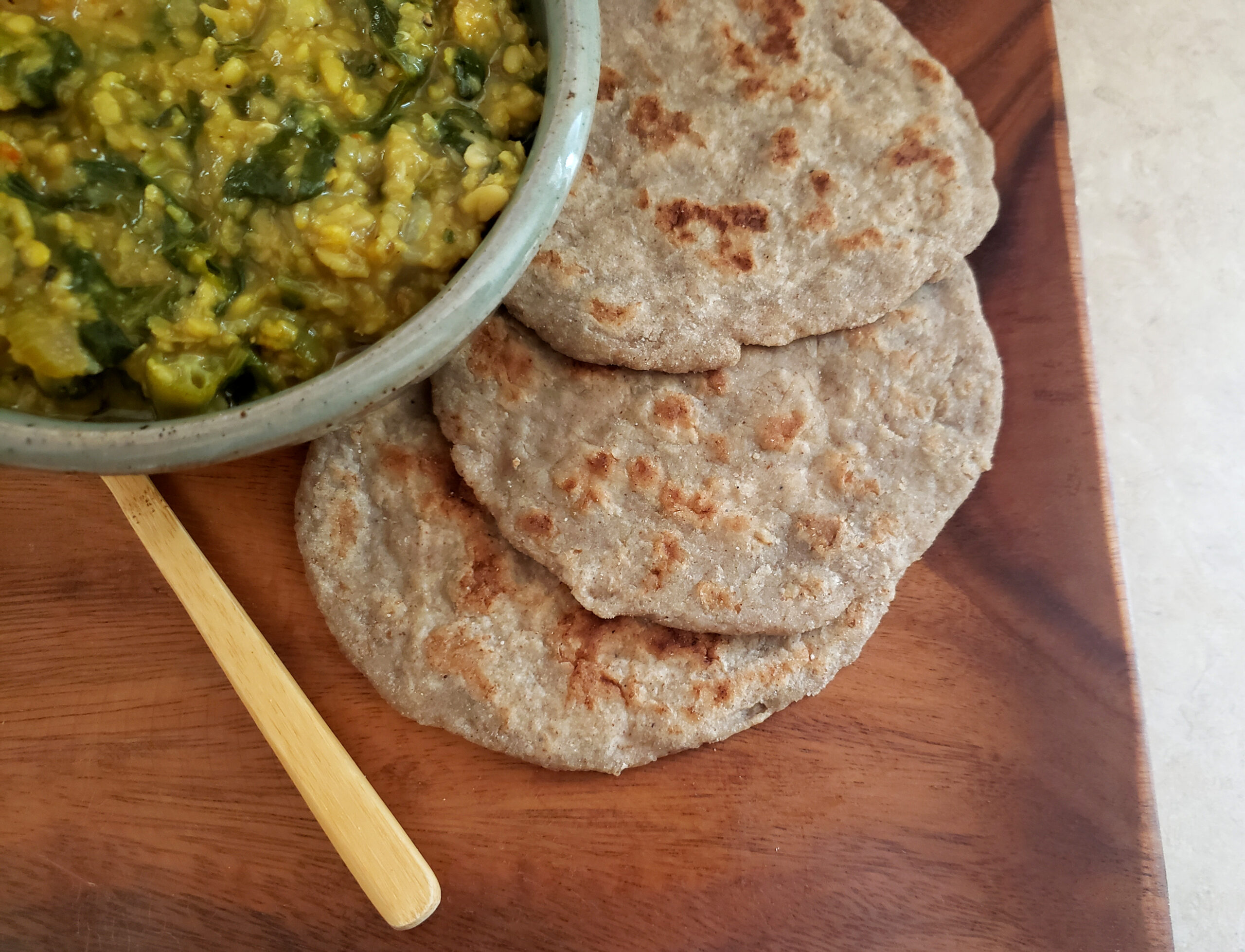
Click here for a printable copy of this recipe.
Directions
STEP ONE: GRINDING THE FLOUR*
*If you are using pre-ground buckwheat flour, just add 1½ cups (240 grams) of flour to a medium mixing bowl and move to “Making the Dough”.
1. Place ¾ cup (120 grams) of buckwheat groats in an electric spice grinder and grind for 1 to 2 minutes to create a fine powder.
2. Sift out any large chunks using a sifter or mesh strainer. Add the flour to a medium mixing bowl.
3. Repeat steps 1 and 2 with the remaining ¾ cup (120 grams) of buckwheat groats.
4. Grind an extra ½ cup of buckwheat groats and set aside separately to use for sprinkling the surface when rolling out the dough.
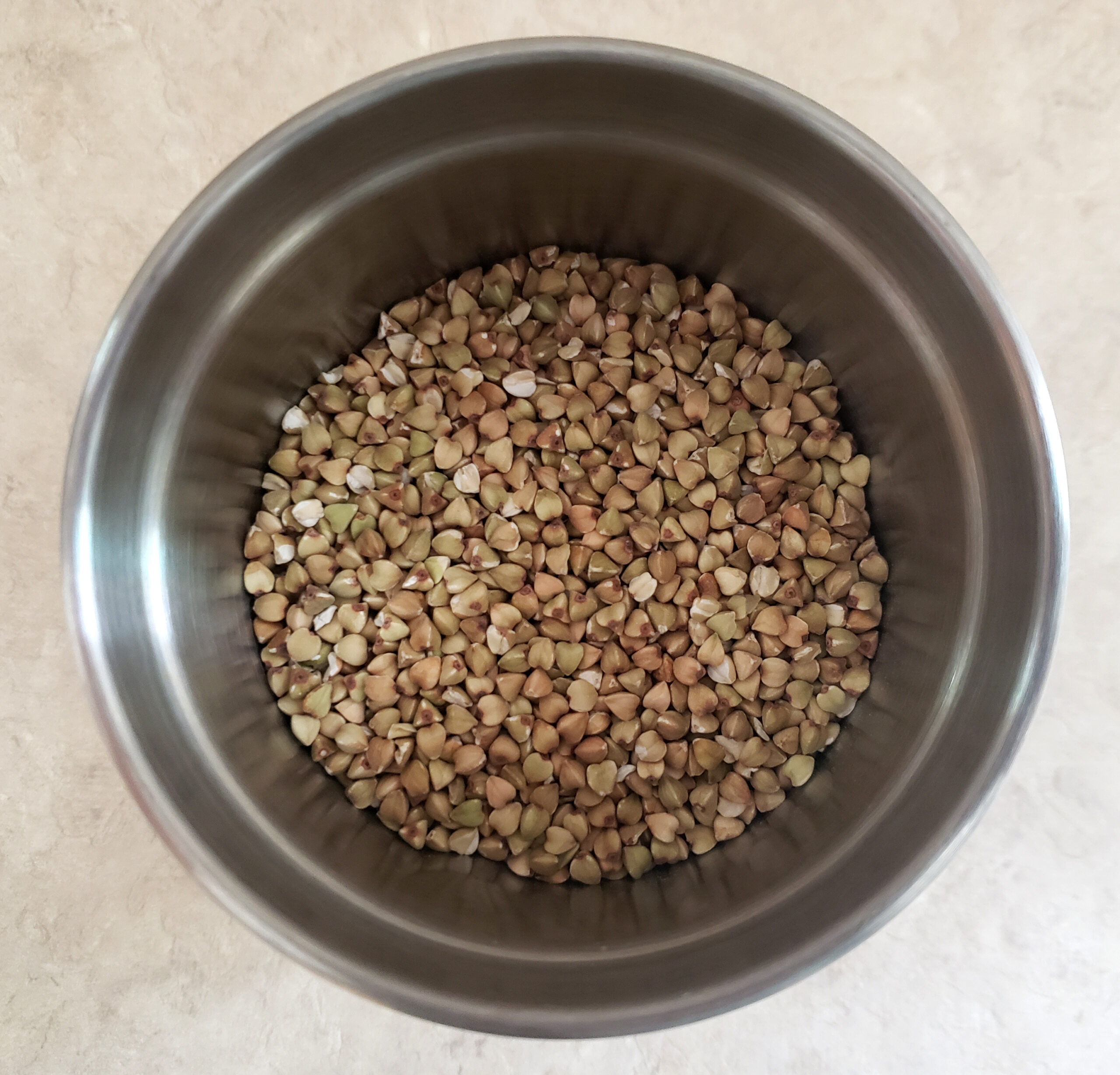
Whole raw buckwheat groats
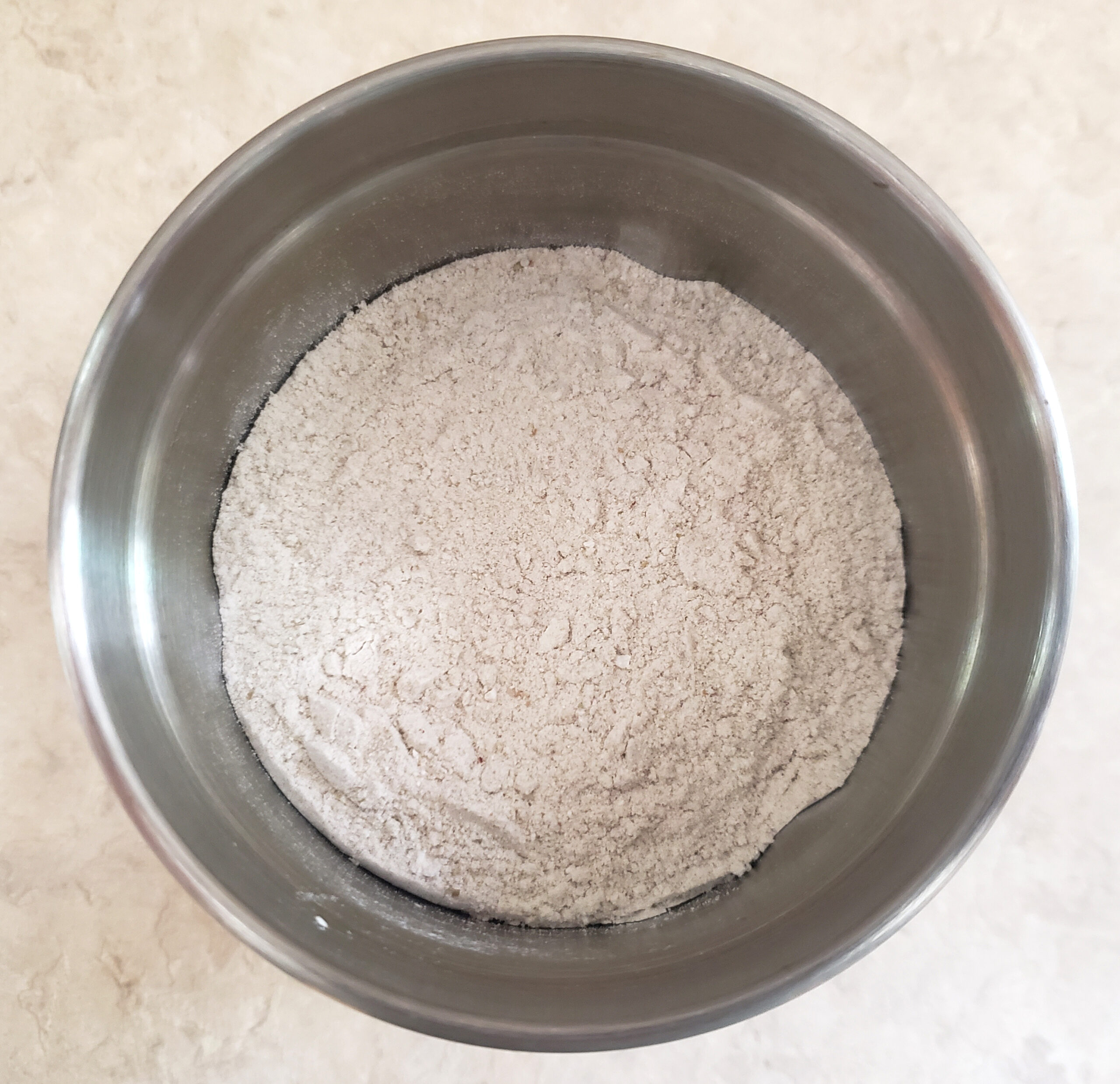
Raw buckwheat groats ground into flour
STEP TWO: MAKING THE DOUGH
1. Add the water, oil, salt, and psyllium husk to a small mixing bowl. Stir well until everything is evenly blended and there are no clumps. Let this sit for a few minutes until the mixture congeals to form a gel-like texture.
2. Add the psyllium mixture to the buckwheat flour and mix well with a large wooden spoon until everything is evenly combined and there are no lumps or dry flour—it’s ok if it is still a little sticky!
3. Begin to heat a cast-iron griddle over medium heat.
4. Sprinkle a clean, dry surface with a small amount of the extra buckwheat flour.
5. Knead the dough on this surface for 1 to 2 minutes. Then make a round ball.
6. Flatten the dough ball and cut it into 8 even parts. Then shape each part into a small ball.
7. Re-sprinkle the surface with additional buckwheat as needed. Place one of the dough balls onto the surface and “roll” it out with oiled hands (this works great for me!) or an oiled rolling pin, as preferred. The final flatbread will be about the size of a small plate (4-5” or so) and about a quarter-inch thick.
TIP: If the dough gets sticky when rolling it out, just sprinkle it with more buckwheat flour.
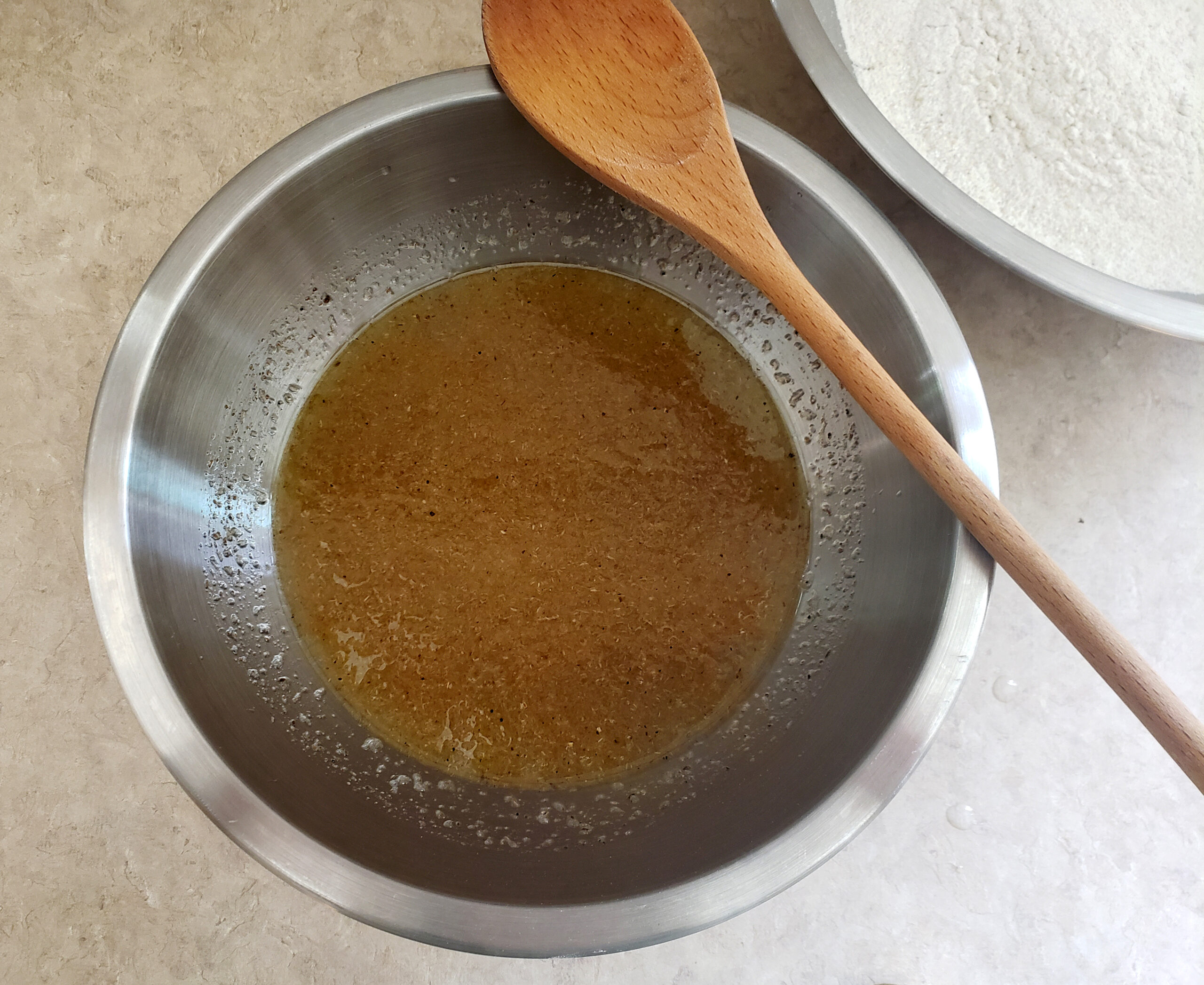
Psyllium husk soaking in water, oil, and salt
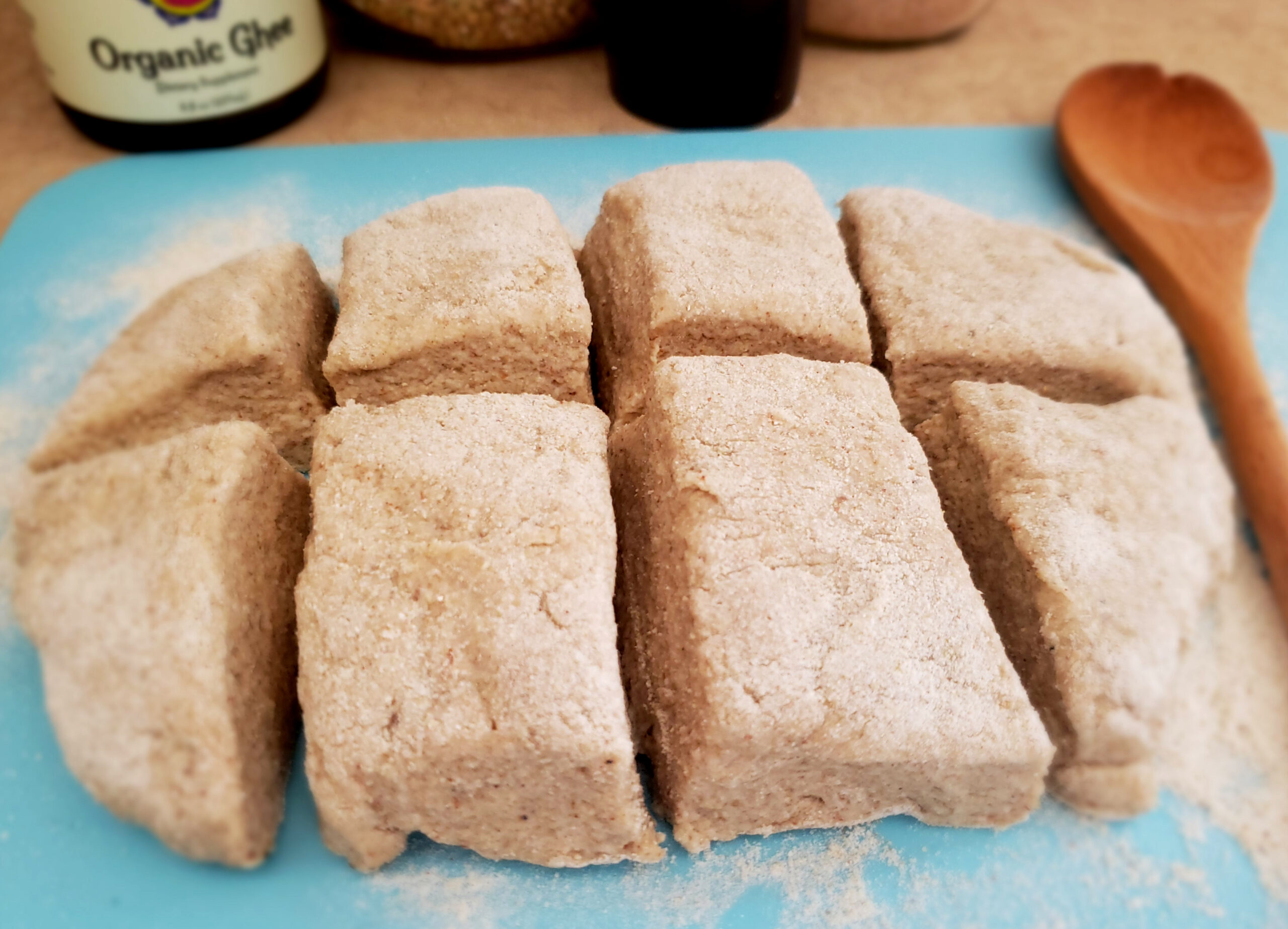
Kneaded dough cut into eight even sections
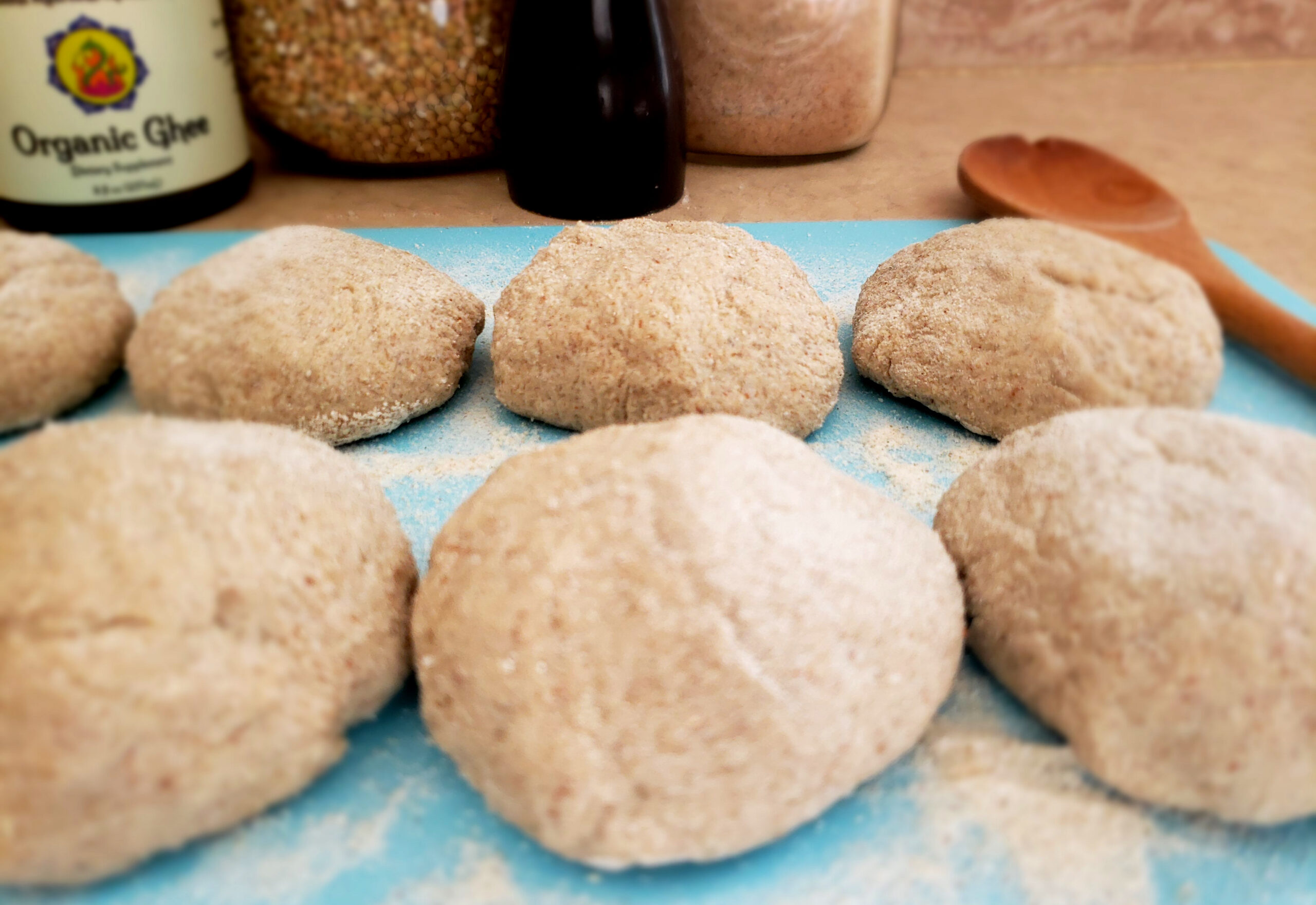
Dough rolled into eight small balls
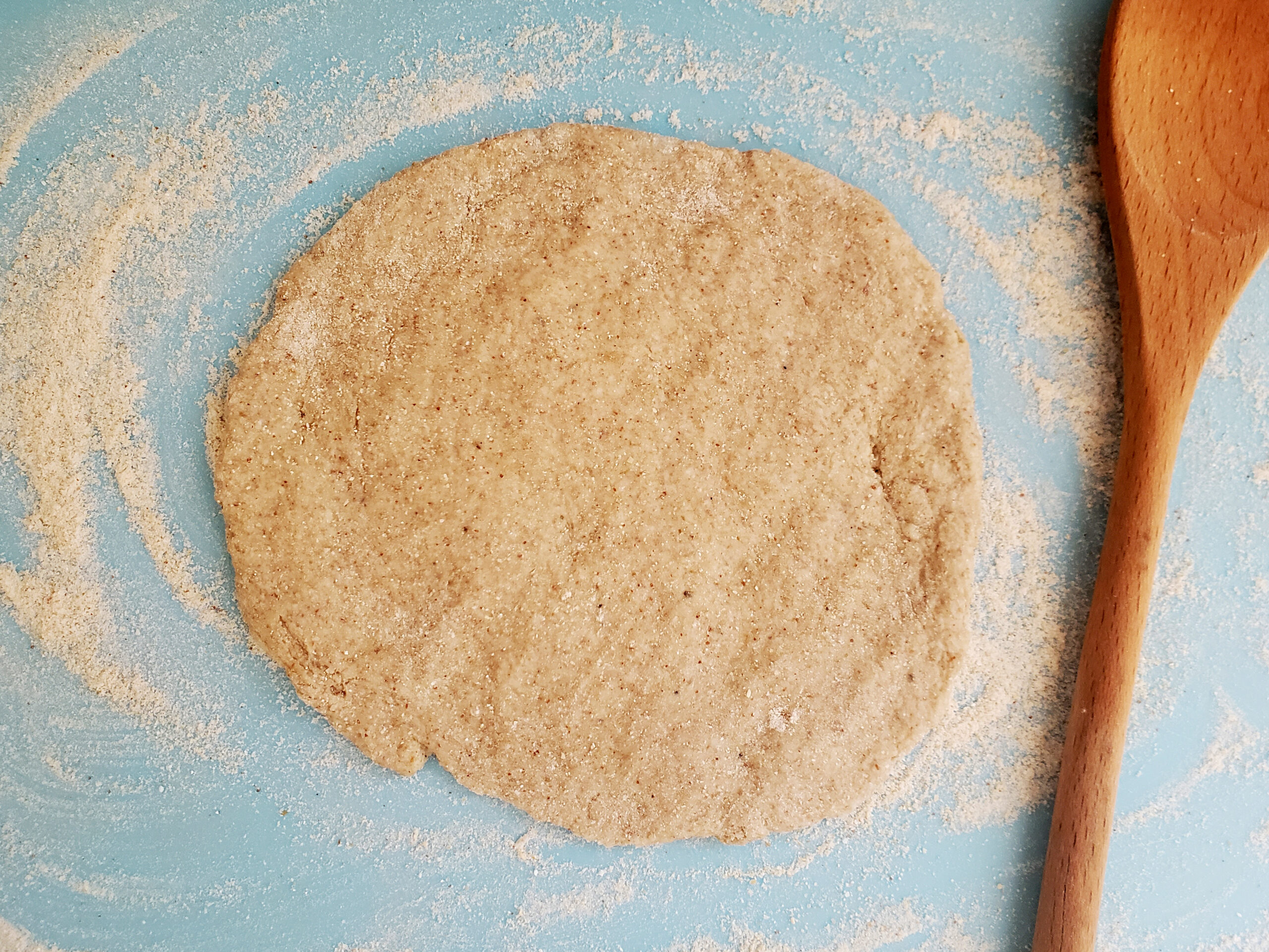
Dough rolled into a 5″ flatbread (I “rolled” this by hand, no rolling pin needed!)
STEP THREE: COOKING THE BREAD
1. Add a small amount of ghee to the heated griddle. Place the rolled-out flatbread in the middle of the griddle.
2. Heat the first side for about 2 minutes or until the bottom is firm and easy to flip. There may be some golden brown spots, but it should not be black, burnt, or hard.
TIP: While each flatbread cooks, you can roll out the next flatbread.
3. Flip the flatbread and cook the other side for another 2 minutes or until the bread is cooked slightly firm with a few golden brown spots.
4. Place the cooked flatbread onto a cooling rack (best!) or plate. While it is still warm, glaze it with a small amount of ghee to add a nice flavor and some extra moistness.
5. Repeat this cooking process until all of the flatbreads have been made.
6. Enjoy this soft and delicious flatbread with soup, kitchari, dal, hummus, or any meal you desire! It also works great as a gluten-free wrap or mini-pizza crust!
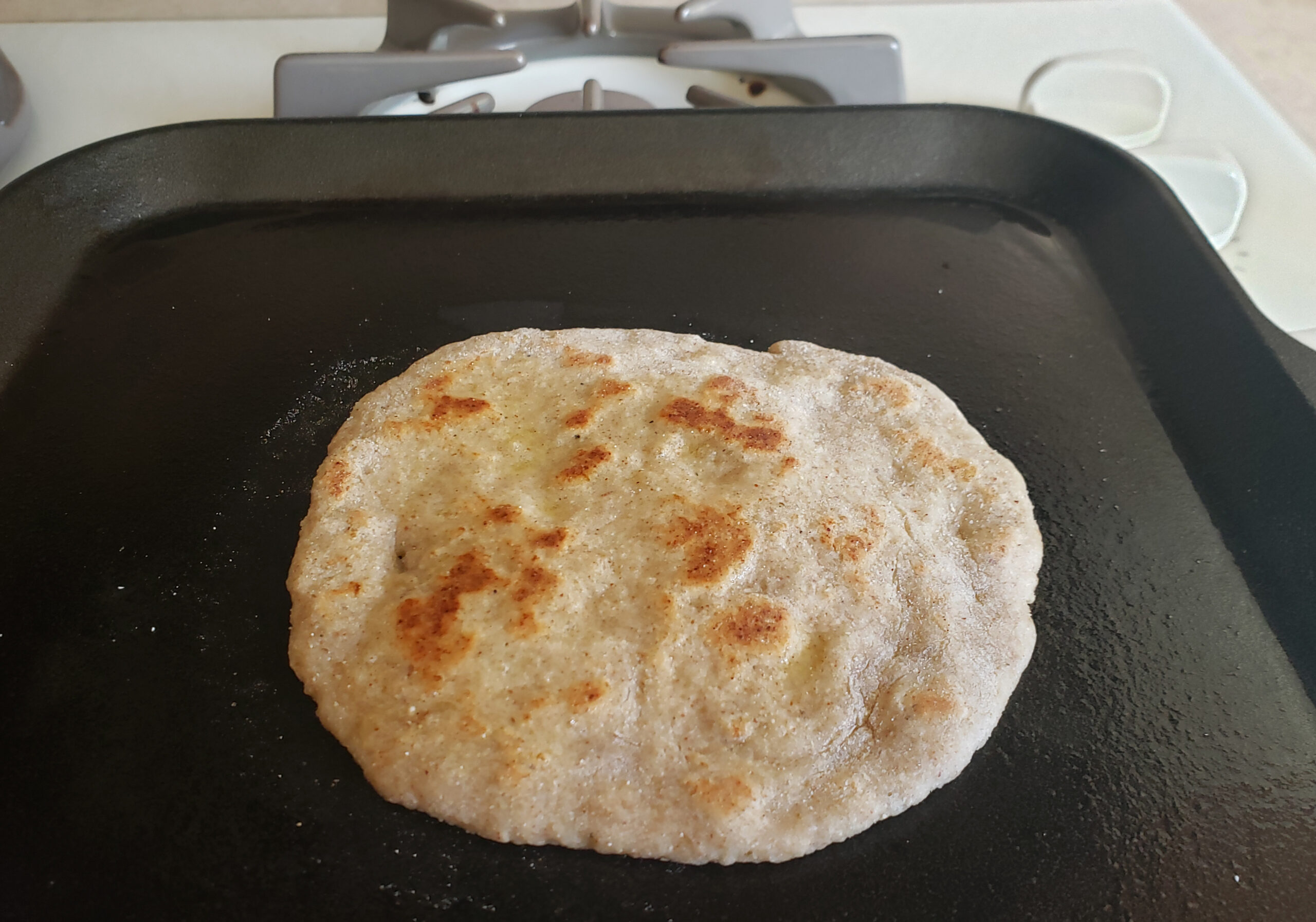
Buckwheat flatbread cooking over medium heat on a cast-iron griddle
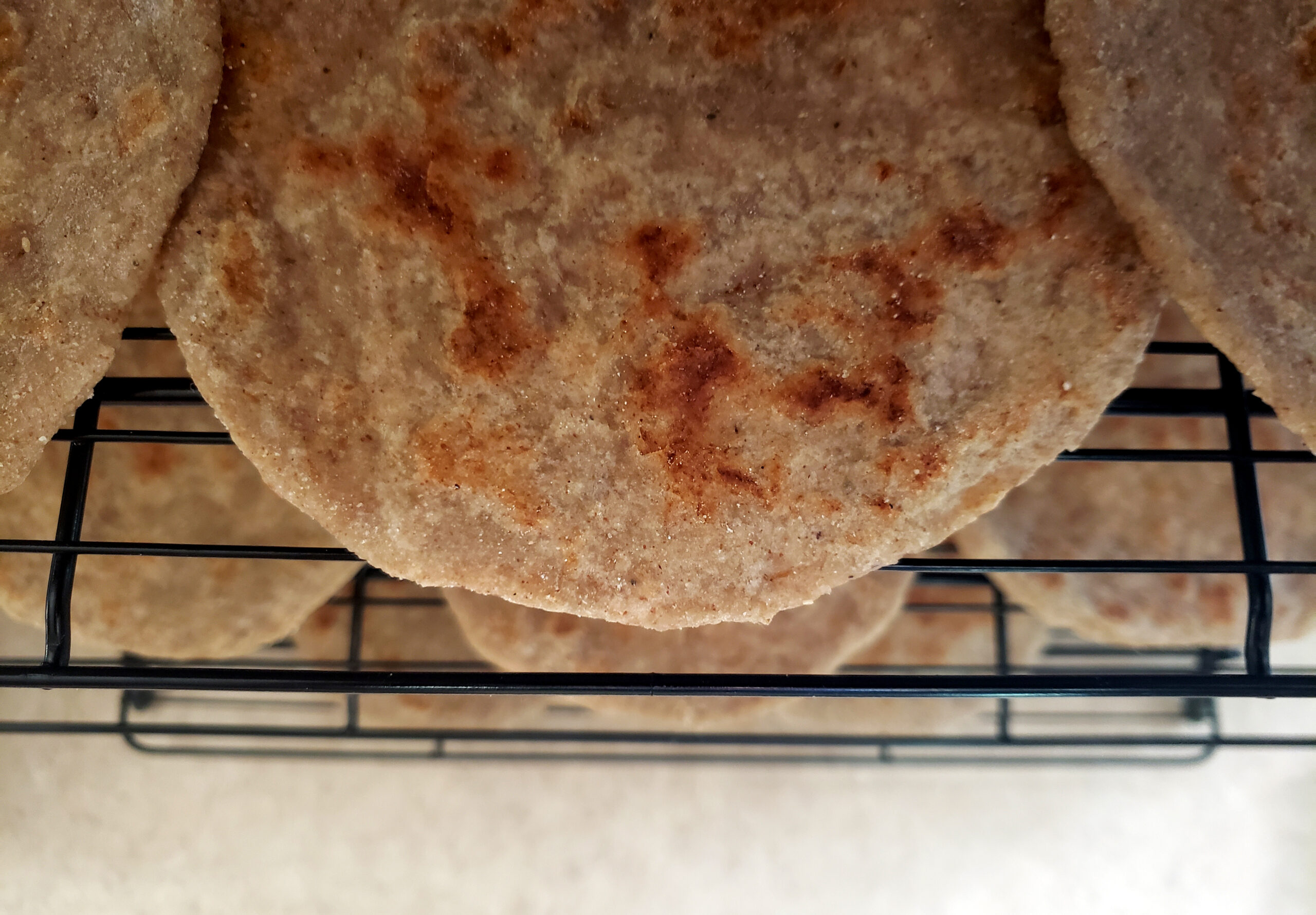
Cooked flatbread cooling on a baking rack
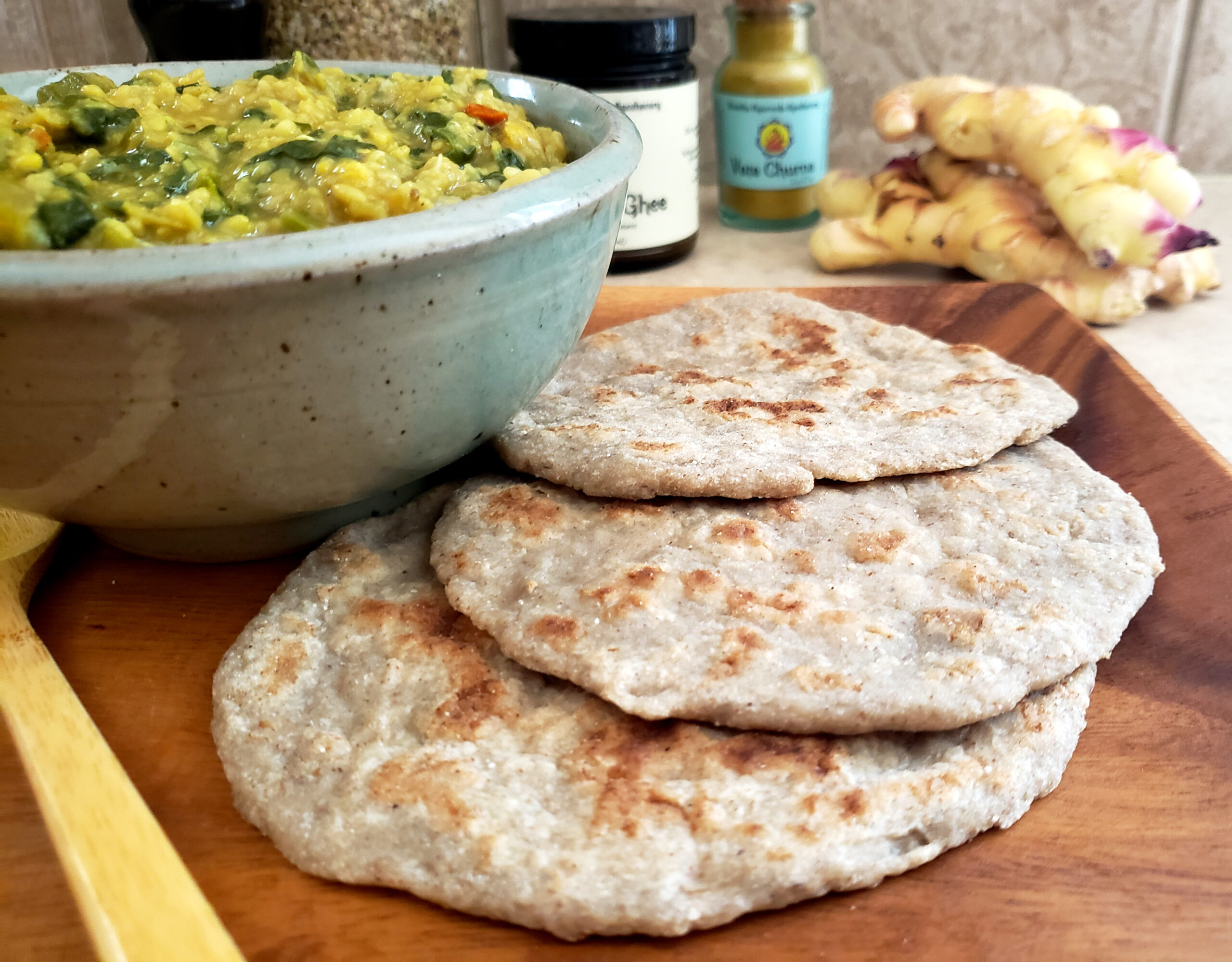
Finished buckwheat flatbread, ready to eat with some delicious kitchari:)
Storage Tips
- Wrap any extra flatbread in Saran Wrap or a zip-lock bag for the best freshness.
- It can be stored at room temperature (but away from any sunlight or heat) for up to 4 days. The bread tends to keep its softness best with this method, so feel free to make a smaller batch if needed.
- Store in the refrigerator for up to 7 days, although it will become harder and drier with cold storage.
- Store in the freezer for up to 3 months. Place them in a glass container and separate them by placing a piece of parchment or wax paper between each flatbread. Thaw at room temperature for several hours before reheating (see below) and eating.
Reheating Tips
- No matter the method for storing, it is recommended to reheat the bread before eating.
- Reheating options include: place over an open flame on the stove (similar to warming a tortilla), warming it on a heated, dry cast-iron griddle (about 30 to 60 seconds per side over medium heat), or placing it in a 250º oven for 2 to 4 minutes (wrap in tin foil to avoid drying out).
- If the bread seems dry, you can brush it with a small amount of ghee or olive oil after the warming process.
Optional Doshic Variations
VATA
Buckwheat and psyllium husk can be slightly drying for Vata; however, the addition of oil and ghee will balance out the dry qualities, so make sure to brush the flatbread generously with ghee after cooking. You can also add Vata-soothing spices such as Vata Churna, Agni Churna, turmeric, cumin powder, basil, rosemary, oregano, thyme, hing, or fenugreek powder to aid in digestion (and add flavor!).
PITTA
Although buckwheat is considered heating, the psyllium husk helps to cool this recipe down. If it still seems too heating for your Pitta, you can add in some cooling spices such as minced cilantro, chopped parsley, Pitta Churna, coriander powder, or fennel powder. Ghee is also very cooling, so brushing the bread with ghee (or coconut oil) after cooking will help to reduce any heating properties.
KAPHA
This recipe is naturally Kapha-reducing, as buckwheat is one of the best grains for Kapha dosha. If you have a severe Kapha imbalance, such as obesity, severe water retention, high cholesterol, or high blood pressure, it would be best to reduce the salt to ¾ teaspoon and replace the ghee with olive oil. Adding heating digestive spices can make any food more Kapha-friendly. The best options for Kapha would be Kapha Churna, Trikatu, turmeric, black pepper, garlic, oregano, thyme, rosemary, cayenne pepper, and minced chile peppers.
Discover our complete line of Ayurvedic Spice Blends!
Find all of your Kitchari essentials here!
Discover more healing recipes with my 30-Minute Ayurvedic Cookbook!

